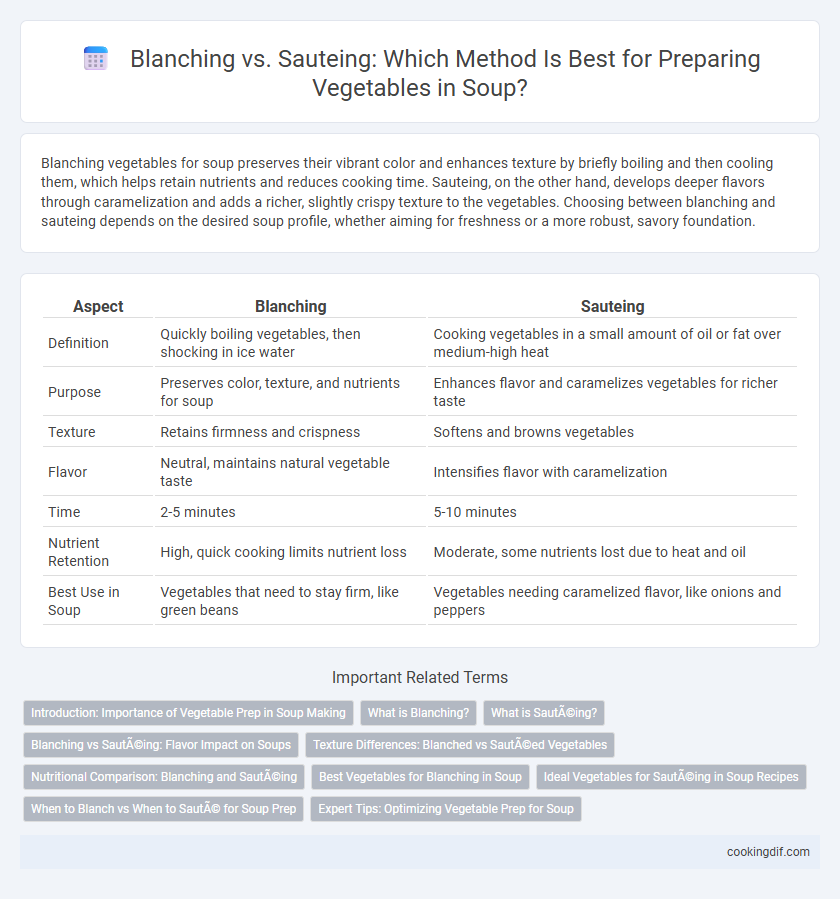Blanching vegetables for soup preserves their vibrant color and enhances texture by briefly boiling and then cooling them, which helps retain nutrients and reduces cooking time. Sauteing, on the other hand, develops deeper flavors through caramelization and adds a richer, slightly crispy texture to the vegetables. Choosing between blanching and sauteing depends on the desired soup profile, whether aiming for freshness or a more robust, savory foundation.
Table of Comparison
| Aspect | Blanching | Sauteing |
|---|---|---|
| Definition | Quickly boiling vegetables, then shocking in ice water | Cooking vegetables in a small amount of oil or fat over medium-high heat |
| Purpose | Preserves color, texture, and nutrients for soup | Enhances flavor and caramelizes vegetables for richer taste |
| Texture | Retains firmness and crispness | Softens and browns vegetables |
| Flavor | Neutral, maintains natural vegetable taste | Intensifies flavor with caramelization |
| Time | 2-5 minutes | 5-10 minutes |
| Nutrient Retention | High, quick cooking limits nutrient loss | Moderate, some nutrients lost due to heat and oil |
| Best Use in Soup | Vegetables that need to stay firm, like green beans | Vegetables needing caramelized flavor, like onions and peppers |
Introduction: Importance of Vegetable Prep in Soup Making
Proper vegetable preparation significantly impacts soup flavor and texture, with blanching preserving vibrant colors and nutrients by briefly boiling vegetables before shocking them in ice water. Sauteing develops deeper flavors through caramelization, enhancing the soup's overall taste profile by intensifying the vegetables' natural sweetness and aroma. Selecting the appropriate technique depends on the desired soup consistency and flavor complexity, influencing the final dish's sensory appeal.
What is Blanching?
Blanching is a cooking technique that involves briefly boiling vegetables in water or steaming them, then quickly cooling them in ice water to halt the cooking process. This method preserves the vegetables' color, texture, and nutritional value, making it ideal for preparing ingredients for soups. Blanching also helps remove surface dirt and reduce bitterness, enhancing the overall flavor profile of the dish.
What is Sautéing?
Sauteing is a cooking technique that involves quickly cooking vegetables in a small amount of oil or fat over medium-high heat to enhance flavor and texture. This method caramelizes the natural sugars in vegetables, creating a rich, savory base ideal for soups. Compared to blanching, sauteing adds depth and complexity by developing a nuttier, slightly crispy exterior without softening the vegetables excessively.
Blanching vs Sautéing: Flavor Impact on Soups
Blanching vegetables for soups preserves their natural color and subtle flavors, resulting in a cleaner, fresher taste profile that complements delicate broths. Sauteing intensifies the flavor by caramelizing the vegetables' sugars, adding depth and richness to the soup's base. Choosing blanching yields a lighter, more vibrant soup, while sauteing creates a robust, savory foundation.
Texture Differences: Blanched vs Sautéed Vegetables
Blanching vegetables for soup preserves their vibrant color and results in a crisp-tender texture by briefly boiling and then shocking them in ice water. Sauteing vegetables, in contrast, enhances flavor through caramelization, producing a softer texture with slightly browned, tender edges. These texture differences impact the mouthfeel of a soup, with blanched vegetables offering a fresh, firm bite while sauteed vegetables deliver a richer, more complex flavor profile and tenderness.
Nutritional Comparison: Blanching and Sautéing
Blanching preserves water-soluble vitamins such as vitamin C and folate by quickly boiling vegetables and then cooling them, minimizing nutrient loss compared to prolonged cooking. Sauteing retains fat-soluble vitamins like vitamins A, D, E, and K due to the use of oil, but may result in greater leaching of water-soluble nutrients if cooked at high temperatures for extended periods. Both methods impact nutrient retention differently, with blanching favoring preservation of hydrophilic vitamins and sauteing enhancing bioavailability of lipophilic compounds.
Best Vegetables for Blanching in Soup
Blanching is ideal for vegetables like green beans, broccoli, and peas in soup preparation, as it preserves their vibrant color, texture, and nutritional value by quickly boiling and then shocking them in ice water. This method helps maintain the crispness of these vegetables, preventing them from becoming mushy during the longer cooking process of the soup. Blanched vegetables integrate seamlessly, enhancing the soup's appearance and flavor while ensuring a balanced, fresh taste.
Ideal Vegetables for Sautéing in Soup Recipes
Sauteing is ideal for vegetables like onions, garlic, bell peppers, and mushrooms, which develop richer flavors and enhanced textures through this quick, high-heat cooking method. These vegetables release natural sugars and aromatics, boosting the depth and complexity of soups compared to blanching, which primarily softens vegetables without intensifying their taste. Incorporating sauteed vegetables early in soup recipes enhances both the aroma and savory profile, making the final dish more robust and satisfying.
When to Blanch vs When to Sauté for Soup Prep
Blanching vegetables for soup prep is ideal when you want to preserve vibrant color, crisp texture, and reduce cooking time, especially for greens and root vegetables. Sauteing is better suited for building flavor through caramelization and softening vegetables like onions, garlic, and peppers before adding liquids. Choosing blanching or sauteing depends on whether your soup benefits from fresh, bright bites or rich, developed flavors.
Expert Tips: Optimizing Vegetable Prep for Soup
Blanching vegetables before adding them to soup preserves vibrant color and crisp texture by briefly boiling and then shocking them in ice water. Sauteing enhances flavor through caramelization, creating a rich base that intensifies the soup's aroma and depth. Expert chefs recommend blanching sturdier vegetables like green beans for better texture retention, while using sauteing for aromatic veggies such as onions and garlic to unlock robust savory notes.
Blanching vs Sautéing for vegetable prep Infographic

 cookingdif.com
cookingdif.com